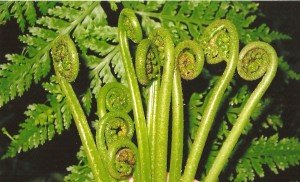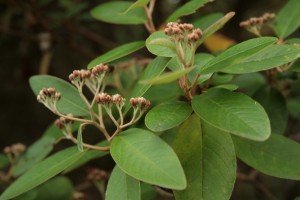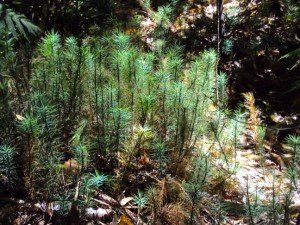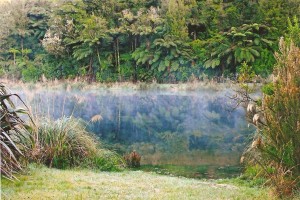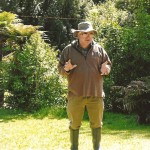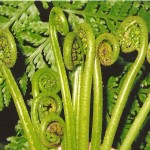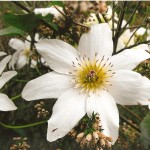Presented by Rob McGowan in Dunedin 25 November 2010
One of the issues that is a growing concern to practitioners of rongoā Māori is the growing difficulty in accessing the plants they need for their rongoā (medicine). This has a number of serious consequences; one of course is that rongoā are not available; another, not often considered, is that the mātauranga (traditional knowledge) concerning certain rākau (plants and trees) is gradually being lost: the plants are not available to keep that mātauranga alive. As a result more and more knowledge is being lost with the passing of each of the old healers. There has been a tremendous amount of work, particularly with the Treaty of Waitangi claim Wai 262, to protect the IP (intellectual property) issues surrounding rongoā. That is very important, but there has been much less attention to, let alone realization of, the fading plant resource.
This presentation will outline some of the reasons for the loss of species used for rongoā, and suggest ways in which the situation can be addressed.
Introduction:
The “State of the Environment” report issued in 2007 records the continuing decline in New Zealand’s biodiversity. In particular the report notes that “Over the last 200 years, much of New Zealand’s most accessible and productive land has been cleared or modified for a range of different land uses, such as agriculture, horticulture, roading and human settlement. As a result many of our lowland and coastal forests, lowland grasslands, wetlands, dunelands, and estuaries have been modified. These habitats and ecosystems are particularly at risk of being modified further if they occur on, or are adjacent to, prime agricultural and horticultural land”[1]
The decline of New Zealand’s biodiversity is the subject of much research and discussion. However what are the impacts of this decline in biodiversity on rongoa Maori, both its continuing use, and the matauranga, the knowledge base, that has developed over the centuries concerning rongoa Maori, in particular those aspects of rongoa which involve the harvesting and uses of plant material?
That is the focus of this presentation. Experience suggests that when practitioners of rongoa are no longer able, over a period of time, to access the plants they have traditionally used, the knowledge surrounding that use gradually fades. This particularly is the case with the intergenerational transmission of matauranga. Knowledge is lost with the passing of each generation of healers.
The following presentation does not come out of a carefully planned research programme. It is the result of years of day to day involvement with rongoa Maori. It reflects many decades of working with traditional healers throughout the country, years of using rongoa and preparing it for others, and in the last 20 years, the experience of helping to pass on the traditions and knowledge of rongoa Maori, traditional Maori medicine.
What it hopes to do is highlight some very fundamental issues that are currently very often talked about by people who work with rongoa, with the hope that it will share their concerns with a much broader group of people, people who, hopefully, will come to regard these issues as something that requires serious attention, and are in a position, in time, to contribute towards addressing them.
Wai 262:
There is a lot of concern and a lot happening to retain the matauranga relating to rongoa Maori, and major efforts to protect it; Wai 262 still awaits the Waitangi Tribunal’s report, after so many years. In the claim there is a major focus on Intellectual Property issues, and the legal framework necessary to safeguard matauranga Maori. However it is my contention that even more urgent is the need to ensure that the species traditionally used by Maori, for many uses including rongoa, continue to be available. The “Environment New Zealand 2007” report, and numerous other reports in recent times, on the state of New Zealand’s biodiversity, would suggest that this is a matter that cannot be taken for granted. The loss of the plant resource, and the resulting loss of the matauranga associated with those uses, is itself an important dimension to be considered by the Tribunal.
We are not primarily talking about historic matauranga, carefully recorded by explorers, ethnographers, enthobotanists, etc., over the last 200 years. We are talking about matauranga that continues to live on in the lives and practices of practitioners, who carry on the practices of those who have gone before them, and adapt and extend them to meet the needs of an ever changing world.
There are many dimensions to rongoa Maori. In this paper the focus is particularly on the harvesting and use of plants for medicine, but the term is much broader than that, and plant use is not the most important part of traditional Maori medicine. I am constantly reminded by kaumatua from different iwi that the foundation or rongoa is not rakau, trees and plants, but taha wairua, something spiritual. That is the case now as it ever was. However, having said that, matauranga Maori has at its foundation its connection to the natural world, te Wao nui a Tane, and if that connection is not kept alive, Maori culture itself will slowly lose its meaning and relevance.
That applies particularly to rongoa; Maori in the 21st century are an urban dwelling people. Rongoa Maori is an important vehicle in retaining that connection to the whenua and to the ngahere. But it is not just a spiritual, intellectual, psychological or emotional concept. The physical act of going to the ngahere, the bush, to collect rongoa has a much wider significance than the medical properties particular rongoa may contain. It is representative of the connection between the children of Tane and Papatuanuku, the Earth Mother, and collection of rongoa gives expression to that connection. If the rongoa plants are not longer readily accessible that connection starts to become increasingly tenuous. Many present day Maori have little knowledge of the ngahere, and have little or no involvement with it. The continuation of the practices associated with rongoa, as traditionally understood by Maori, are key to retention of the matauranga that is associated with it.
However, as the following comments will show, that access to rongoa is increasingly in doubt.
Getting in touch with the reality: outlining the issues:
Some years ago I had happened to visit the far North during several successive springs. That pleased me at the time; there is lots of kumarahou (Pomaderris kumeraho) in the North, and that is a rongoa much prized, but for people living further South, usually difficult to obtain. And so as I travelled North I would always look for Kumarahou, and sometimes collect some to take home. Over the years it became harder and harder to find; for some reason it was quietly disappearing from the landscape. That’s not surprising when one knows the ecology of the plant; it is a pioneer species, one of the first to come up after a fire or a slip, or when a forest is logged. As soon as it becomes shaded by the species that succeed it, it disappears. But what was happening at the time is that in places where I used to find kumarahou it was not other native trees and shrubs succeeding them, as was the norm in the past, but a host of exotic weed species; blackberry, gorse, woolly nightshade/tobacco weed, ginger, and so many more that were invading the landscape. Kumarahou was being displaced, squeezed out, by weeds.
Along with that something more was happening. When asked about kumarahou more and more people were saying things like; “My nannies used to use kumarahou a lot but we don’t do that now; it’s getting hard to find”. Once the plant is lost soon the memories of the plant begin to fade; matauranga is lost. That is a major issue that needs to be addressed.
Contemporary use of rongoa Maori:
The use of rongoa Maori is not receding; in fact it is experiencing a real resurgence. This is happening for a number of reasons.
The first is the cost factor; modern medicine is becoming more and more expensive, and many individuals and especially families are not able to afford the medications proscribed by medical professionals. As a result more and more people look to other ways of addressing their needs. Rongoa at times does provide an available alternative. This is sometimes compounded by a loss of confidence in pharmaceutical medicines. There is a fear of side-effects and the possibility of addictions.
A further reason is that the use of traditional Maori medicines can be an assertion of Maori identity.
There are two major issues:
The first is that the plants traditionally used for rongoa are becoming increasingly hard to find in many parts of the country. A map of the vegetation of New Zealand highlights the fact that the areas most deplete in indigenous species is where most people live; and consequently, where there is likely to be the greatest call for rongoa.
The second follows from that; when the healers can’t find the plants they need they cease to use them, and often don’t pass on their knowledge about those plants, in the way that they themselves learnt, to those that will carry on the traditions after them; in time more and more matauranga is being lost.
This paper will first briefly explore some of the reasons why rongoa plants are disappearing, and the consequences of that. Once that has been discussed, some practical suggestions are made to address the situation.
Obviously this is too big a question to be dealt with in this short paper. The aim of the paper is to bring the issue to people’s attention. Hopefully enough will be said to catch people’s interest, and this will stimulate some, with a range of abilities and skills, to contribute towards exploring the question more fully, and especially, direct some of their energy into contributing to its solution.
Reasons for the disappearance of rongoa plants:
1. Where to find rongoa:
A big number of the species used for rongoa are found in the regenerating fringe of the forest. A traditional way of describing the situation is to say that the plants that heal the land are also the ones that heal the people who live on the land. (Often the best way to work out the medicinal properties of a plant is try and understand what the role that plant has in the process of regeneration, and then to look for ways of applying that to healing sicknesses in people and animals). On open ground these species are the first stage of the regeneration of the landscape. A good example is the way tutu (Coriaria arborea) colonized areas covered by pumice and ash after the Tarawera eruption in 1886.
In an established landscape these are often the species that make up the fringe that protects the species that grow within it. (In Whanganui the term te totarahoe is used to describe this part of the ngahere). They keep the wind and sun out so that the canopy species within can stand tall and strong and the subcanopy species beneath them can thrive in the protected environment. In a healthy forest the fringe is constantly renewing and extending itself, so that usually most of the species involved continue to persist in the landscape.
It is a natural process; it varies in different parts of the country, according to climate, altitude, geology, and local biodiversity, etc., but there is always a range of species that fulfils this role, and amongst these are found many of the main species that were traditionally used for rongoa.
But a quick look at the forest fringe in most parts of the country these days will show a very different scenario. Where once would have been found a range of indigenous species; manuka, kanuka, tutu, kumarahou, mamaku, mingimingi, karamu, etc. one is more likely to find exotic species; gorse, blackberry, cotoneaster, wattle, pine, especially Pinus contorta, ginger, woolly nightshade, morning glory; the species vary around the country but for much of New Zealand, particularly the further north one goes, exotic weed species dominate not just the landscape fringes, but even large areas of regeneration.
Some species will in time give way to indigenous species; gorse often proves to be a very useful nurse plant for a returning forest. But very often the exotic species increasingly dominate the landscape, and a succession of indigenous species disappear. Some weed species, Japanese honeysuckle for instance, prevent any other species from re-establishing and can lead to a monoculture. Among the indigenous species that are lost are a number of species important for rongoa.
2. Many of the plants used for rongoa are very palatable:
Some years ago I was in Pureora forest in Central North Island. I remarked to the local DOC workers who I was with that there was a lot of raurekau, but they all seemed to be about the same age. My guess at the time was that they were about 6 to 7 years old. My mates laughed; they told me that was about how long since there had been a 1080 drop. That had knocked out the deer that ring barked the mature trees, and ate any seedlings, and the rats and mice that ate the seeds.
Plants like raurekau, also known as manono or kanono, karamu, makomako, hangehange and many others are often described as “ice-cream” to many animals. The practice of turning stock into the bush over the winter still persists, and that, with various feral species such as deer, goats, wallabies, is eliminating more and more species. In many places the understory of the forest is best described as a desert. The affect is exacerbated by the effect that canopy grazing species, particularly possums, have on the canopy. A further contribution to the decline of the forest is the effect of rodents, rats and mice, eating the seed that falls to the ground.
Again, a number of species traditionally used for rongoa, gradually disappear from the landscape.
Consequences of the loss of rongoa species:
The first role of the rongoa plants is to heal the whenua, the land itself. It is easy to forget this. We are so worried about our own concerns, our needs, or sicknesses and injuries that we easily fall into the way of thinking that everything in creation is for our own personal use. We are much less important than that; in fact, as healers, our first patient is the land itself; our first duty is to heal Papatuanuku. It is only when the land itself is well can it heal the living things that belong to the land, ourselves included.
The plants used traditionally for rongoa have a key role in helping the land recover from the many natural events that have always happened. The recent earthquake in Christchurch, the many flood events that happen each year, the droughts, high winds, and fires are most often natural processes; the various plant species that recloth the land repair the damage so that life can continue to thrive. The affect of the loss of the indigenous species that repair the damage is much researched and well documented.
In many parts of the country the seed trees have long since disappeared, the seed bank in the soil is depleted or even totally exhausted, so that the land is incapable of responding to the urgency of a natural disaster. Search the roadsides and hillsides of parts of Hawkes Bay, Waikato, Canterbury for even the most common reveg species and one will be often disappointed; they have disappeared from the landscape.
The birds and insects that depend on the trees also disappear, so even if the plant species do in fact survive, that is of little benefit if the species that pollinate them, or distribute their seeds, are no longer present. Admittedly many New Zealand indigenous species are self pollinating or wind pollinated, and many seeds are wind or water dispersed, but insect and bird pollination, and bird distribution of seeds play a significant role in the maintenance of biodiversity and the restoration of a landscape.
Other factors:
Pollution, contamination issues:
A final issue needs to be introduced. Even when rongoa plants do survive in the landscape they may not be safe to harvest; they are often contaminated in some way. A good example are plants that grow on the edge of a road. That may be the only place where some species survive in an area, but often they are covered in dust, affected by fumes, and contaminated by the rubbish that people throw out of their car windows. Waterways may be contaminated by a range of pollutants, and remnants of bush, often in unfarmable gullies, are used as rubbish dumps. Thee are a range of cultural issues which also result in some areas being unsuitable for harvesting. The presence of certain wahi tapu is an example of this.
Traditionally healers were very careful in selecting sites for harvesting rongoa. Many a time healers will return home empty handed, because they are unable to find rongoa that meet their careful criteria. That is becoming an increasingly common event.
Practical responses:
The purposed of this paper is to highlight the impact of the decline of diversity on the retention of the matauranga relating to rongoa Maori. It is an issue that warrants much more substantial treatment than this brief presentation. However it is worth noting some practical possibilities to address the issues raised.
1. Rongoa species make a good tool for monitoring biodiversity:
Because some of the many species used for rongoa are part of the regenerating fringe of the forest their presence or absence, can, in itself, be a very good indication of the health of a local forest remnant, riparian area, etc. Often when it is only when one starts to look for rongoa that one realizes how profound the decline of biodiversity may be. Some parts of the country have large areas of manuka with little else thriving. A manuka forest should have a host of other species within it, working towards succeeding the manuka. In many cases this is unlikely to happen, because of the factors already outlined.
2. Restoration plantings:
There is a major effort throughout the country to restore indigenous vegetation to the landscape, on roadsides, riparian areas, restoration projects on land set aside for conservation. Traditionally the bulk of the plantings have consisted of those species that are easy and quick to propagate and grow on in a nursery, and reliable to plant in a landscape. That has often meant a relatively narrow range of species is used, and not necessarily species historically present in a particular landscape.
It is important that species selected for a particular restoration site represent the range of species that were historically present on the site. That would include some species that might be slower, and more expensive to propagate and establish. By doing that not only would a site once again be covered with the original indigenous species, rather than exotic species, but the avian and invertebrate biodiversity may also stand a chance of being re-established.
That in turn would help re-establish a resource for use for rongoa, and help ensure that the local knowledge relating to rongoa be passed on.
3. Planting for rongoa:
In many parts of the country, particularly those areas where there is a significant Maori population, it may be necessary to plant up areas specifically for use as rongoa. This is not a new idea; there are historical examples of this happening in pre-colonial times. However modern realities suggest that this be done on a much more substantial scale than in the past.
It is important to remember that rongoa plants are part of a landscape; traditional practice suggests that their medicinal properties in plants relate in many cases to the environment in which they grow, and the species with which they grow. That is why many rongoa practitioners insist, as far as possible that rongoa be collected from the local ngahere.
Companion planting isn’t a new invention. We have become used to a landscape dominated by monocultures of useful species, kiwifruit, applies, kumara, echinacea, etc. That is not the way to grow plants for rongoa. In establishing a rongoa garden we need to take note of the natural associations of species, and try and reflect that in our own plantings, to gain maximum benefit for the landscape, and all the species that are part of the landscape, ourselves included.
4. Maintaining matauranga rongoa:
Most present day New Zealanders, Maori included, have little knowledge of the ngahere. Twenty years of involvement in teaching rongoa has shown that very few people can identify the most of the plants used for rongoa, let alone have an understanding of traditional ways of harvesting rongoa to ensure that it is done sustainably. A rongoa clinic can quickly exhaust local resources in a very short time, and this is happening.
If rongoa Maori is to survive there needs to be a very positive programme to reconnect people to the environment. It needs to be something that begins in the kohanga reo, and continues right through the education process. Country living people can more readily come to an appreciation of how totally they depend on the well being of the landscape for their own health and well being. City people are just as dependent; everybody needs clean air and water, and regular healthy food to survive. However it all seems rather remote and something taken for granted if one lives a busy city life.
It is easy to learn about the traditional uses of plants for medicine; there are various publications that are very helpful. But rongoa Maori is not just about information, collecting and using data; it’s about the living connection between ourselves and the living world of the forest. That can only be gained by going into the forest and getting to know it as a friend, with all of its changes and moods, in all of the seasons. It can’t be done quickly, but it is the right place to learn; it is “te Wananga nui a Tane”.
For that we need a healthy forest.
One could say that modern cites are the most devastating monoculture that the planet has ever known.
[1] Environment New Zealand 2007, Published by the Ministry for the Environment, December 2007, p. 353
